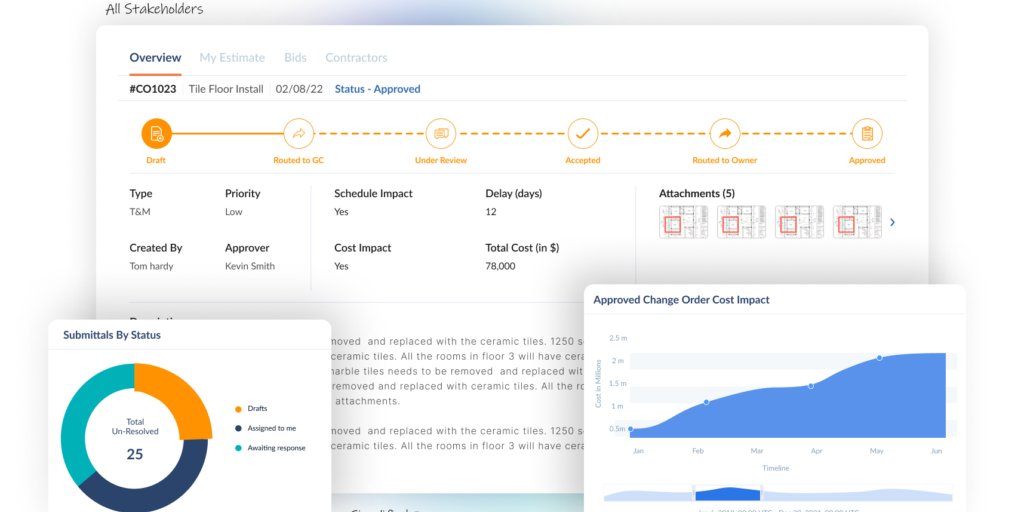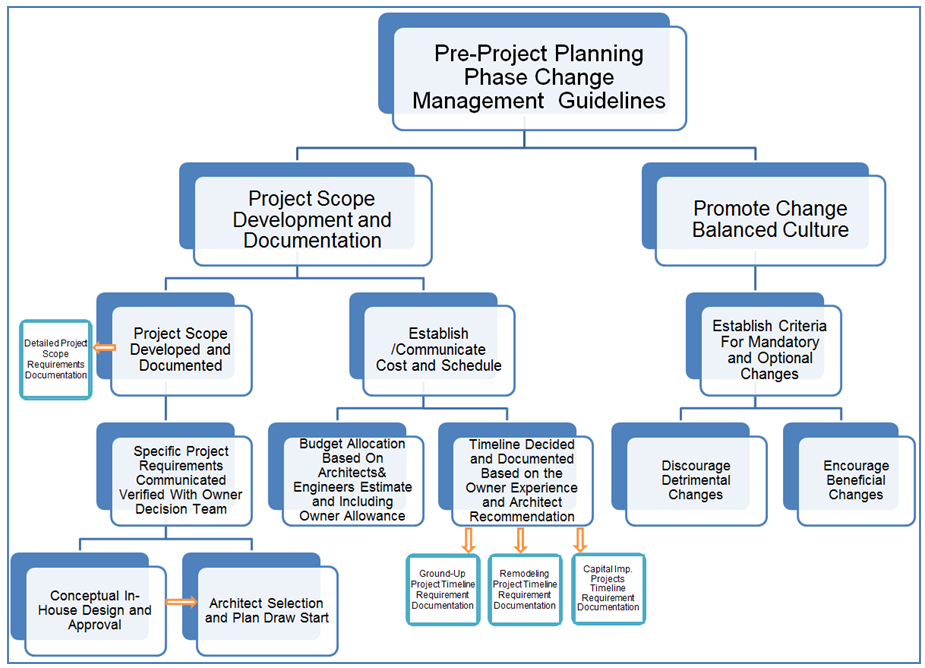The Definitive Guide to Construction Change Orders

Construction professionals know that change orders are a fact of life on any construction project.
No matter how well planned and carefully budgeted, there will always be circumstances, site conditions, and design changes that modify the contract.
Change orders can be small, such as adding an extra electrical outlet, or significant, such as moving a wall or completely reconfiguring the building’s floor plan.
Whether large or small, change orders are an ongoing concern for owners, developers, and contractors. And if not carefully managed, change orders can cause friction and legal conflict while adding significant time and cost to a construction project.
Here’s what we cover:
- What is a change order?
- There are two primary categories of change orders
- Who initiates the construction change order process?
- What are the most common causes for construction change orders?
- Who benefits from a change order?
- What are the negative consequences of change orders?
- How does the change order process work?
- Architect-initiated change orders
- Change Order Request (COR) vs. Change Order (CO)
- What is a Construction Change Directive (CCD)?
- Owner-initiated change orders
- Contractor-initiated change orders
- Change orders can also begin as a Request For Information (RFI)
- What are the steps in the change order process?
- How are change orders compensated?
- How are change orders added to the construction contract?
- How do you draft a change order?
- What are the benefits of effective change order management?
- Six simple tips for effective change management
What is a change order?
A change order is a legal directive that amends the construction contract’s terms and conditions.
The purpose of a change order is multifold
- Adapt and respond to unforeseen events.
- Change the terms of the contract.
- Alter the design, scope of work, schedule, or project cost.
- Document the chain of events leading to the contract changes.
- Protect all project stakeholders from legal and financial recourse.
- Ensure all stakeholders know the new contract terms and work scope.
- Maintain forward progress and ensure construction continues.
Change orders affect the project’s design, the scope of work, and the schedule, often resulting in additional time, materials, and cost, but not always.
There are two primary categories of change orders
Construction contracts are typically changed by
- Additive change order
- Deductive change order
What are additive change orders?
As the name implies, additive change orders modify the contract by adding elements that expand the scope of work, increase the schedule duration, and add materials and costs.
Scope of work additions could include
- Changing or modifying design elements,
- Requesting alternate delivery methods,
- Increased labor requirements,
- Additional materials and equipment costs, or
- Alternative services, testing, and supervision.
Additive change orders are a common source of friction and litigation in construction projects. However, proper preconstruction planning can resolve many potential change events before project kickoff.
When stakeholders take full advantage of the preconstruction phase, they’re often able to identify potential conflicts and design issues before the project begins.
Preconstruction planning helps avoid costly changes, saving time, money, and frustration.
What are deductive change orders?
Deductive change orders eliminate design elements or otherwise reduce the scope of work in some way.
Reducing the scope of work typically reduces the contract price and can sometimes shorten the project schedule. But this isn’t always good news for the contractor.
One form of deductive change, the Partial Termination for Convenience, partially terminates the contract, removing large sections from the original scope of work.
Partial Termination for Convenience clauses and deductive change orders can be a source of friction and litigation. Contractors risk losing material deposits, equipment charges, and months of wasted effort.
Investing substantial time into the preconstruction process is critical to ensuring all stakeholders are clear on the project scope and expectations.

Who initiates the construction change order process?
Owners, design teams, and contractors create change orders at various times during construction.
The key is establishing a documented process so that every stakeholder knows how to manage and respond to change events when they occur.
Project owners, architects, and engineers often add or eliminate design elements, alter material types or quantities, or change the project’s engineering and architectural design after construction begins.
But change orders aren’t always initiated by the design team or the owner.
General contractors and subcontractors also contribute their fair share of change order requests.
Contractor-initiated change orders typically relate to unforeseen site conditions, unstable soils, design errors or omissions, changes in the governing codes or regulations, or changes related to equipment availability.
Contractors may also request a change order if the materials specified in the contract are no longer available or if new materials or equipment become necessary.
Project owners and developers sometimes view contractor change requests as opportunistic attempts to increase their margins.
For this reason, contractors need to review the contract documents thoroughly during preconstruction and request clarity whenever they find ambiguities in the contract documents.
A thorough preconstruction process goes a long way toward avoiding misunderstandings, contentious change orders, conflicts, and delays.
What are the most common causes for construction change orders?
- Additions or reductions to the scope of work
- Design errors and omissions
- Conflicting or substandard specifications
- Unstable site conditions (poor soils, etc.)
- Additive, deductive, and no-cost design changes
- Safety considerations
- Accelerated schedule requests
- Value engineering changes
- Changes to the construction process
- Skilled trade shortage or labor dispute
- New government regulations
- Material resource or equipment shortages
- Material substitution or procedure change
- Conflicting information between contract and plan sheets
- Contractor or owner financial trouble
- Technology change
- Weather conditions
Who benefits from a change order?
Several stakeholders can benefit from a change order.
Here are a few examples:
- Project owners may benefit when changes improve the project’s functionality, aesthetics, or value.
- General contractors benefit if the change order earns additional revenue or allows them to avoid potential claim disputes with the owner.
- Subcontractors or suppliers benefit if the change order adds additional work or material compensation to their contract.
- The entire project team benefits if the change allows them to value engineer elements that improve the overall project and their performance.
It’s important to note that change orders can also have negative consequences.
What are the negative consequences of change orders?
Frequent changes can deplete morale and hinder productivity. And quality can be adversely affected by frequent schedule interruptions and delays.
Here are several more of the most commonly cited negative consequences.
- Increased project costs
- Schedule delays
- Insurance claims and claim disputes
- The added stress and diminished worker resilience
- Reduced productivity
Maintaining an open dialogue between stakeholders in a spirit of collaboration helps mitigate contract changes and minimize the quality, cost, and schedule impacts change orders often cause.
Forming collaborative partnerships during the preconstruction process has proven to help avoid significant disputes and disruptive change throughout the project.
How does the change order process work?
Get a custom demonstration of the Linarc automated change order workflow here.
The architect, project owner, prime contractor, or one of the many subcontractors can initiate a change order at any time during the construction phase.
Architect-initiated change orders
Architects often amend the project design, provide additional information, or make minor changes to the project’s scope of work through an Architect’s Supplemental Instruction (ASI) form.
ASI directives are not official change orders. But ASI directives change the agreement, and contractors must follow their direction.
If the contractor charged with making the change feels the ASI directive is beyond the project scope, they can dispute it and request compensation through a Change Order Request.
Change Order Request (COR) vs. Change Order (CO)
There is one fundamental difference between a change order request and a change order.
A Change Order Request (COR) is not a change order, nor does it imply that a change is warranted, required, or authorized.
Change Order Requests are documents that propose or request a change in the scope of work. They include a detailed description, drawings and specifications, and requests for costs or time adjustments.
On the other hand, a Change Order is a document that formally documents and approves the changes requested in a change order request. In addition, it outlines the agreed-upon changes to the project and any associated cost or time impacts.
Change orders are signed by both parties, contractor and owner, indicating they agree to the new terms.
However, change order requests are not always followed with an official change order.
The architect can follow up the Change Order Request with a Construction Change Directive (CCD).
What is a Construction Change Directive (CCD)?
A Construction Change Directive (CCD) is similar to a change order in that it directs the contractor to change the scheduling, materials, or design-related elements of the construction project.
The big difference is that contractors do not have to agree with the CCD. Furthermore, construction change directives do not assure payment.
A Construction Change Directive (CCD) instructs the contractor to implement the change immediately to keep the project moving forward, even when the owner and contractor have yet to agree on changes in the contract sum or schedule.
The CCD binds the contractor to perform the work in question but acknowledges that the contract must still be amended by change order if the costs or time associated with the work accumulate beyond the project’s original scope.
But be warned.
This 2021 study by Arcadis reports that project owners across all sectors are adopting more robust post-claim resolution processes. Contractors are now required to justify payment requests with detailed contemporaneous documentation.
That means it’s even more critical for contractors to accurately document the time, materials, resources, and supervision required to complete construction change directives to ensure just and fair compensation.
In any case, Change Order Requests are valid responses to an Architect’s Supplemental Instruction (ASI) directive and Construction Change Directives (CCD).
Owner-initiated change orders
When the project owner initiates the change, they often issue a Request For Proposal (RFP) or Request For Quote (RFQ) to the general contractor.
The primary difference between these two documents is that owners issue RFPs when unsure how best to proceed, while an RFQ requests a price for specific new work or a required change.
As a rule, RFPs and RFQs require a contractor response within fifteen (15) days of the request. Contractors must respond with at least a preliminary estimate to remain in compliance.
The initial change order estimate must indicate the impact of the owner’s proposed changes on the contract price, payment schedule, production schedule, and milestones, including the substantial completion date.
It’s worth noting that a failure to respond within the allotted time or a refusal to change the contract terms by either party can be grounds for breach of contract litigation.
Contractor-initiated change orders
General contractors and subcontractors request change orders when they find discrepancies in the contract documents or conditions that fall outside the scope of their contract.
Contractors submit Change Order Requests either as self-initiated claims or as responses to proposal requests, RFIs, or ASIs that, in their opinion, modify the contract scope.
Change orders can also begin as a Request For Information (RFI)
The prime (or general contractor) will often submit a Request For Information (RFI) when they discover ambiguities or conflicting information in the contract documents, design drawings, or specifications.
When the RFI response results in a change to the project scope, the architect, owner, or agent for the owner will issue a Request For Proposal (RFP) or Request For Quote (RFQ) to address the required change.
In this case, the general contractor must respond following the criteria outlined in the owner-initiated change request above.
What are the steps in the change order process?
The change order process can be simple or complex.
The key is establishing a consistent workflow with fail-safes to prevent the change order process from stalling job progress.
Whether initiated by the owner, general contract, or subcontractors, the change order process follows these basic steps:
- Identify the change: The first step in the change order process is to identify the need for a change. Change orders can address conflicting plan sheets, unforeseen site conditions, additional work requirements, or errors and omissions discovered anywhere in the contract documents.
- Submit change request: The change order request should include a detailed description, an explanation of why the change is necessary, and an estimate of the impact the change will have on the project schedule and budget.
- Review and approval: The review process should have at least two levels: preliminary and final. During the preliminary review, the owner, architect, or project manager determine whether the requested change is necessary and if it is within the scope of the original contract. The final review may require a conference or dialogue with the project team before the owner approves the change.
- Negotiate the terms: If the change request is approved, the parties must negotiate the terms. Negotiations include agreeing to changes in the project schedule and budget and negotiating compensation.
- Execute the change order: After the affected parties agree to the terms, they approve by signing the change order. The signed document includes a detailed description of the change, the impact on the project schedule and budget, and any changes to the contract payment terms.
How are change orders compensated?
Construction change order compensation falls into one of four categories.
- Time and material: Time and material contracts allow the contractor to bill for the time and materials used to complete the change order based on an agreed-upon hourly rate.
- Lump sum: Lump sum contracts are based on a fixed price to complete the change order, regardless of the time and materials used.
- Zero cost: Zero cost change orders do not qualify for additional compensation. Zero-cost changes include work already covered in the contract and minor alternates, such as changing paint colors or floor coverings, when these changes do not represent additional costs.
- Unit cost: Unit cost change orders involve a fixed price for each specific unit of work, such as a square foot of flooring or a linear foot of piping. Contractors track and document installed units, and the project manager, owner, or architect verifies the installations. The contractor receives compensation based on the number of confirmed units installed.
Please note the compensation method for a change order will depend on the original contract’s terms and the change order’s specifics.
No matter the compensation method, a robust job site management system is essential to track and verify expenditures for accurate compensation.
In fact, studies have shown that contractors who track the cost of changes through the Work Breakdown Structures (WBS) in their project schedule are most successful in recouping more of their costs.
How are change orders added to the construction contract?
Change orders are added to the construction contract as amendments and become part of the contract agreement.
Owners and contractors must have a secure document management system to record and track contract changes as they occur.
Failure to manage this aspect of the change order process leads to payment delays, frustration, and costly legal conflict.
How do you draft a change order?
Even though change orders can be problematic, they’re still a fact of construction. So it’s vital to use a standardized change order form.
Your change order document should include the following information at the very least:
- Project name, address, and the original contract number and date.
- Change order number and current date.
- The names and contact information of the project owner, contractor, and project manager.
- A clear and concise description of the contract change.
- The reason for the change, including a narrative explaining the relevant circumstances or events that led to the change.
- Impacts on the schedule and budget.
- The original contract sum, changes to the contract sum to date, and the new contract sum, including the proposed change order.
- A detailed compensation report explaining the date or period scheduled for the work and the contractor’s payment terms for the changes.
- Owner’s, architect’s, engineer’s, project manager’s, or the contractor’s signatures indicating the change order has been reviewed and accepted by all relevant parties.
- And always include the change orders issue date.
It’s essential to include all of this information in the change order document to ensure stakeholders clearly understand the changes and their impact on the project.
The American Institute of Architects (AIA) offers many contract forms for construction. And this form, in particular, addresses the change order precisely.
You don’t have to use an AIA form, of course. But you should follow this AIA change order template while creating your own.
You can find this entire AIA Change Order document and more AIA contract documents here or by visiting https://aiacontracts.com.
What are the benefits of effective change order management?
Effective change order management provides numerous benefits to every stakeholder on the project.
- Improved communication between the project stakeholders: Transparent standardized processes improve communication and lead to more efficient and productive projects.
- Minimized schedule delays: It’s essential to have a clear and transparent process for initiating, documenting, submitting, tracking, and approving project changes. Stakeholders should always know where the change request is in the process and who is responsible for the next step.
- Reduced risk of disputes and claims: Documented change orders eliminate confusion and ease tensions. Misunderstandings lead to costly disputes and claims, which can significantly impact the overall cost and success of the project. Effective change management helps reduce the risk of these types of issues.
Six simple tips for effective change management
Efficient change order management is the key to avoiding cost overruns while maintaining positive relationships and protecting the project timeline.
Follow these six tips to improve the change order process on your next project.
- Define clear roles and responsibilities. Make sure everyone on the project team knows their role and expectations during change events.
Pro tip: Alert stakeholders when a change order request is in their queue, waiting for their response. Automated systems do a great job of streamlining the change order process. - Use a standardized change order form: Standardized forms ensure change orders include all the necessary information.
Pro tip: Digitized forms are convenient, easy to access from a desktop or mobile device, and securely stored in the cloud. - Automate the change order workflow. Automated workflows ensure change orders move through the process efficiently.
Pro tip: Be sure your software platform has a dashboard to track change order progress. Transparency means everyone knows their responsibilities, creating an urgency to the process to streamline approvals. - Establish a change order review committee. The review committee should include the project manager, superintendent, project engineer, architect, owner, or owner’s representative. A joint review committee ensures change requests align with the project’s goals and objectives.
Pro tip: Schedule regular check-ins with your review committee to keep the project team motivated and aligned. - Maintain a central change order log: A central location for logging and storing change orders ensures organized, easy access and tracking.
Pro tip: Digitized change order logs can identify trends and areas to improve decision-making on future projects. - Change order software: Software built for the construction industry can automate the change order process and make it easier to track the status of each change order as they develop.
Pro tip: Everyone on the job site has technology in their pocket. Take advantage of this. Convenient mobile apps eliminate the time-consuming, manual processes that cause errors and schedule delays.
Improve your change order process with automated workflows
The Linarc project management system significantly improves the change order process.
Linarc provides a simple yet cost-effective solution to manage change, reduce risk, and keep your projects moving forward.
Reduce project completion times with an integrated project management system that keeps stakeholders informed and on task.
Get a custom demonstration of the Linarc project management system today—the intelligent, intuitive, easy-to-use tool for managing the complexity of today’s building projects.
Connect – Build – Thrive with Linarc




